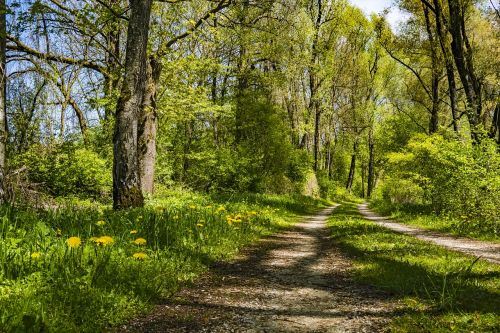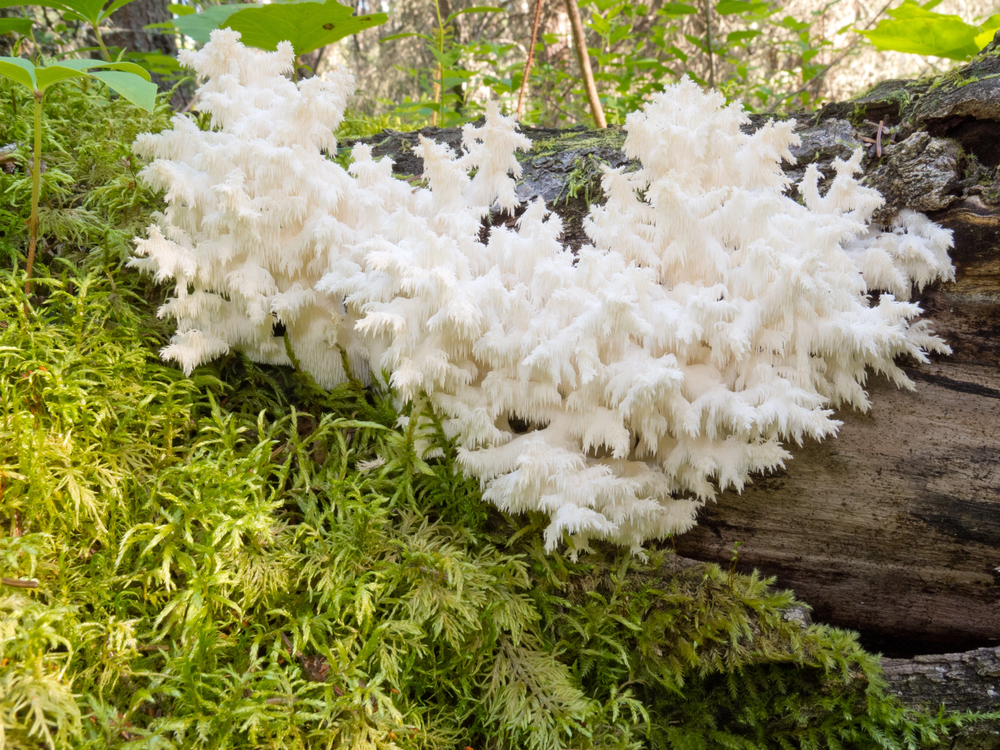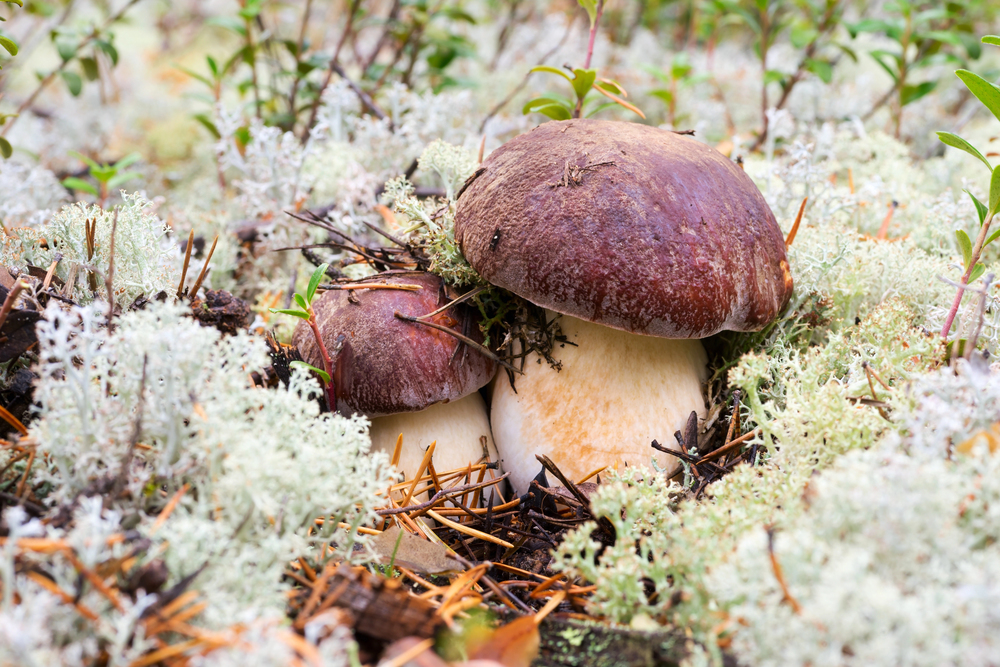When foraging for King Bolete mushrooms, watch out for their look-alikes. The False King Bolete has a reddish-brown cap and blue bruising. The Bitter Bolete additionally sports a reddish-brown cap and yellow pores that bruise blue but tastes extremely bitter. The Bay Bolete features a chestnut-brown cap and slender stem and thrives in acidic soils. Slippery Jack has a slimy cap, especially after rain, and can cause digestive discomfort. The Red-Cracked Bolete has a distinctive red-fissured cap and a mild, nutty flavor. Identifying these will guarantee a safe and enjoyable foraging experience, so let’s dig deeper.
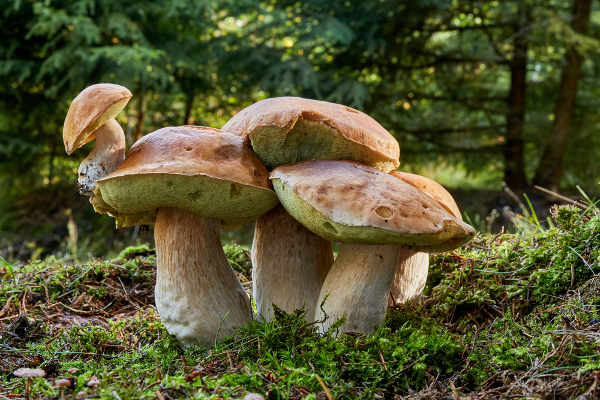
False King Bolete
The False King Bolete, often mistaken for the true King Bolete, can lead to unpleasant surprises for foragers. To avoid this pitfall, pay close attention to identification tips.
The False King Bolete has a reddish-brown cap and exhibits a blue bruising when touched, unlike its true counterpart. Its stem often features a distinctive network of fine, reddish lines.
Habitat differences play an important role: while the true King Bolete thrives under conifers and hardwoods, the False King Bolete prefers sandy soils and often appears near pines.
Bitter Bolete
Another mushroom that often confuses foragers is the Bitter Bolete, which can turn a delightful meal into a bitter experience. You’ll want to watch out for its identifying features: a reddish-brown cap, yellow pores that bruise blue, and a particularly bitter taste.
Unlike the King Bolete, the Bitter Bolete’s bitterness is unmistakable once tasted, making it important to identify it correctly before cooking.
You’ll often find Bitter Boletes in common habitats like deciduous and mixed forests, particularly under oak and beech trees. They thrive in the same environments as the King Bolete, so attention to detail is critical.
Trust your senses and stay vigilant, ensuring your foraging adventures lead to freedom and joy, not a mouthful of regret.
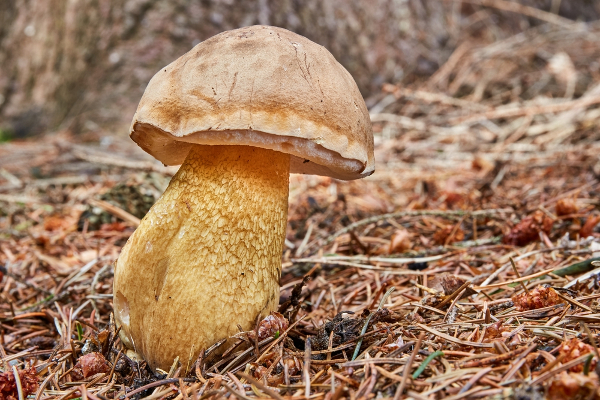
Bay Bolete
Bay Boletes might catch your eye with their chestnut-brown caps and slender stems, often leading to confusion with King Boletes. You’ll find these mushrooms in similar growing conditions, thriving under coniferous and deciduous trees. They’re more common in acidic soils, so keep an eye out in those environments.
When it comes to culinary uses, Bay Boletes are a delight. Their mild flavor makes them versatile in soups, stews, and sautéed dishes. Remember, unlike the King Bolete, the Bay Bolete’s pores stain blue when bruised, helping you identify them.
| Characteristic | Bay Bolete |
|---|---|
| Cap Color | Chestnut-brown |
| Stem | Slender |
| Growing Conditions | Coniferous, deciduous trees |
| Culinary Uses | Soups, stews, sautéed dishes |
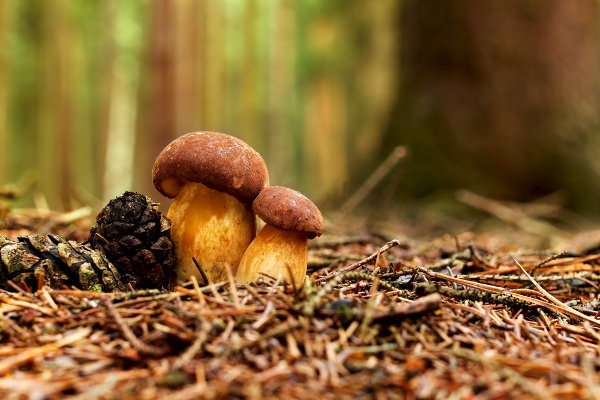
Slippery Jack
If you’re exploring forests after rain, look out for the Slippery Jack with its distinctive slimy cap. This mushroom thrives in coniferous forests, particularly around pine trees. Yet, there are edibility concerns you should be aware of. Unlike the King Bolete, the Slippery Jack can sometimes cause digestive discomfort.
Here are some points to help you identify it:
- Cap: Slimy and sticky, especially after rain.
- Pores: Yellow and easily bruised.
- Stipe: Often adorned with a ring.
- Habitat: Prefers coniferous forests, especially around pines.
If freedom and adventure call you into the woods, remember to approach the Slippery Jack with caution. Knowing its habitat preferences and edibility concerns helps guarantee a safe foraging experience.
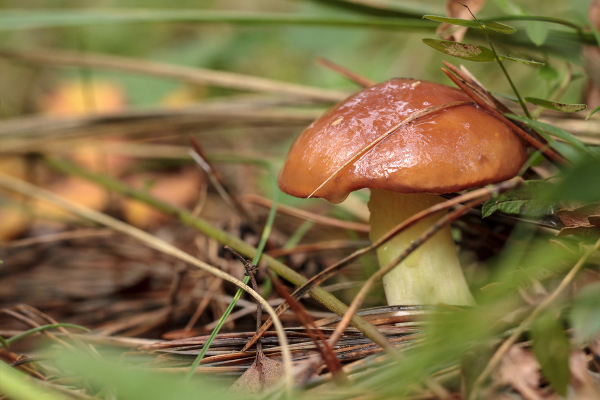
Red-Cracked Bolete
The Red-Cracked Bolete, known for its distinctive red-fissured cap, can be a tricky find for mushroom foragers. You’ll often spot it in deciduous forests, thriving under oak and beech trees—its habitat preferences lean towards warm, temperate climates. When you’re out exploring, keep an eye on the ground; these mushrooms like to hide among leaf litter.
In the kitchen, the Red-Cracked Bolete offers unique culinary uses. Its firm texture and mild, nutty flavor make it a delightful addition to soups and sautés. Nevertheless, always cook it thoroughly to avoid any potential stomach upset.
Appreciate the freedom of foraging and cooking with this wild treasure, and you’ll never look at mushrooms the same way again.
Poisonous Look-Alike Mushrooms
Identifying poisonous look-alike mushrooms to King Bolete requires a keen eye and knowledge of distinct features. The Death Cap (Amanita phalloides) is often mistaken for the King Bolete due to similar cap shape and color, but can be differentiated by its toxic nature.
The Yellow Stainer (Agaricus xanthodermus) resembles the King Bolete in color and size, but can be identified by its yellow staining reaction when bruised.
The False Morel (Gyromitra spp.) is another look-alike with a similar size, but can be distinguished by its wrinkled cap and lack of sponge-like underside. It is crucial for foragers to be aware of these differences to avoid dangerous misidentifications.
Key Differences in Characteristics
Distinguishing between King Bolete and its look-alikes relies on key differences in characteristics like cap color variation, stem shape, and spore prints.
These distinct features are essential for accurate identification and help avoid confusion when foraging for edible mushrooms.
Color Variation in Caps
Differentiating between the genuine King Bolete and its look-alikes can be based on the varying coloration of their caps. While the true King Bolete typically has a reddish-brown to dark brown cap, imposters may show variations in color, ranging from pale yellow-brown to almost black.
Some look-alikes may also display hues of orange, olive, or gray on their caps, emphasizing the importance of closely examining this feature for accurate identification.
Stem Shape Differences
The King Bolete can be distinguished from its look-alikes by its stem shape. Look for these key differences:
- Bulbous Base: The King Bolete has a swollen base that tapers towards the cap, a feature less prominent in its imposters.
- Retaining a Ring: Some King Bolete specimens may have a ring around the stem, known as an annulus, not commonly found in other mushrooms.
- Net-like Pattern: The stem often shows a net-like pattern, called reticulation, aiding in its identification compared to similar species.
Spore Print Contrast
When distinguishing the King Bolete from similar mushrooms, focus on the spore print color. The King Bolete typically has an olive-brown to dark brown spore print, which helps differentiate it from other look-alike species.
This distinct color sets the King Bolete apart from mushrooms that may appear similar but have different spore print hues. Paying attention to spore print color is crucial for accurate identification and a safe mushroom foraging experience.
Geographic Distribution and Habitat
The King Bolete mushroom, scientifically known as Boletus edulis, is widely distributed across North America, Europe, and Asia.
In North America, it is found in oak and pine forests in the east and coniferous forests in the west.
In Europe, it thrives in northern and southern countries, forming mycorrhizal associations with trees like oaks, beeches, and pines.
Similarly, in Asia, it grows under coniferous trees such as firs and spruces in countries like China and Japan.
Its adaptability to different climates and tree associations contributes to its abundance in diverse ecosystems worldwide.
Tips for Safe Identification
Identifying King Bolete mushrooms involves noting key features like:
- Cap color (ranging from reddish-brown to dark brown)
- Stem texture (thick and white with a net-like pattern)
- Spore print color (olive-brown to olive-green)
It is important to observe the habitat, typically near oak, pine, or chestnut trees. To confirm identification, take a spore print by placing the cap on paper or glass overnight to observe spore color.

